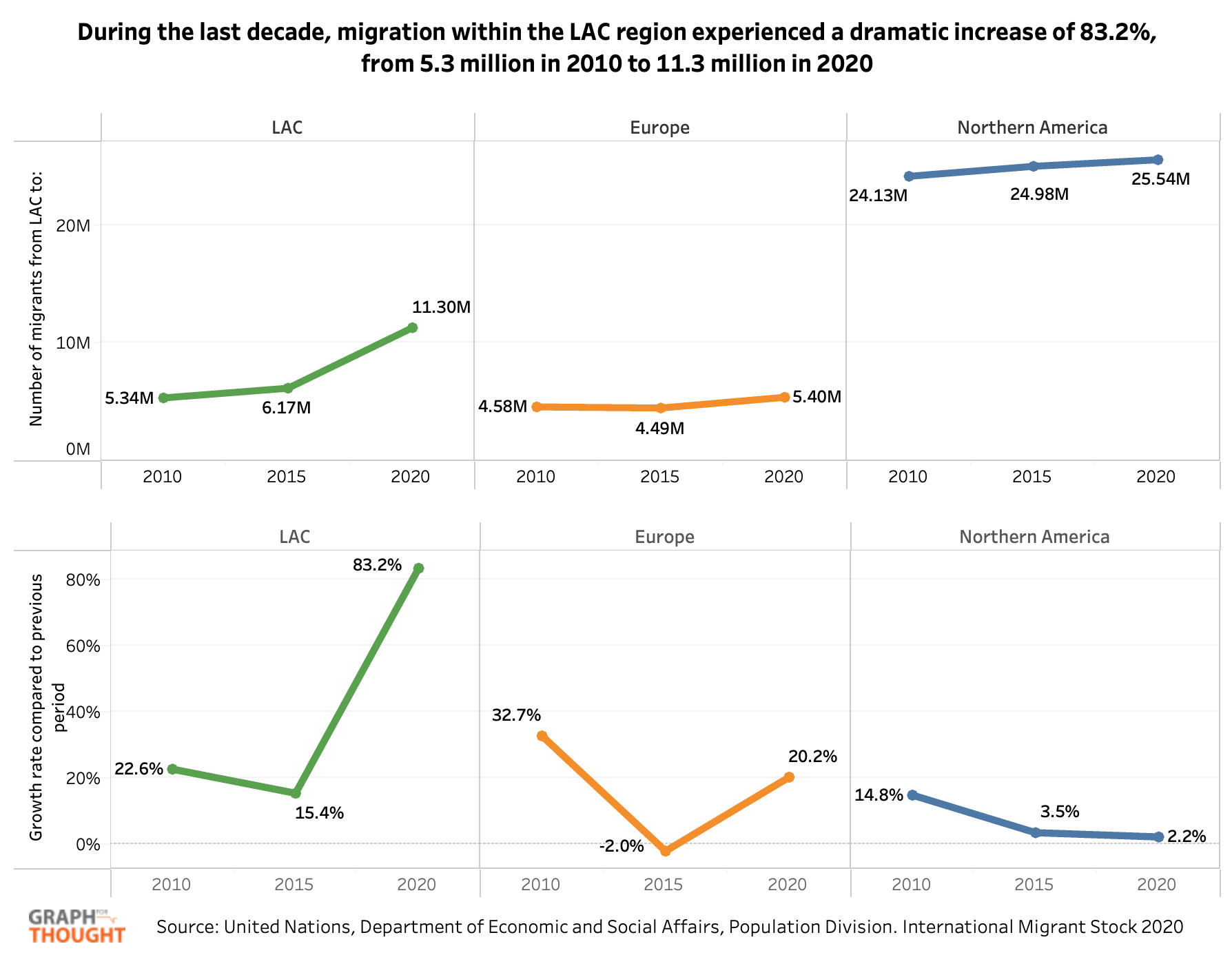Crossing Borders: The Unprecedented Growth of Migration within Latin America and the Caribbean
June 8, 2023
In recent years, migration dynamics in Latin America and the Caribbean (LAC) have significantly evolved. In a previous #GraphForThought, we explored how migration is driven by economic opportunities, job prospects, and “push” factors like violence and limited opportunities in home countries.
This #GraphForThought uses data from UNDESA to analyze changes in migration patterns for the region between 2010 and 2020. Overall, the total number of migrants from LAC increased from 34.6 million in 2010 to 42.0 million in 2020. What has changed dramatically in the last years is where migrants are going. Migration within the LAC region experienced a dramatic increase of 83.2%, from 5.3 million to 11.3 million. Migration to North America, the primary destination for migrants from the LAC region (with 25.5 million migrants in 2020), slowed down considerably (2.2% in 2020), while migration to Europe rebounded after a temporary decrease. This trends in migration have been driven by factors such as stricter immigration regulations in the United States, economic growth in various LAC countries, and an increase in migration from Venezuela since 2015.

New migration flows within LAC pose challenges for governments and host communities, but they also present a tremendous opportunity for the region’s development. Intraregional migration can contribute to regional integration, economic development, and innovation, as well as expand productivity. Evidence has shown that established migration corridors can intensify migration, with migrant networks reducing the costs and cultural barriers involved.
However, short-term costs and negative impacts on certain population groups, coupled with misinformation and prejudice, can lead to strong anti-migration attitudes in the region. According to Latinobarómetro 2020, the perception of LAC countries towards migrants is varied. In most countries, about 50% of the population consider it positive or very positive to receive Latin American immigrants, except in the Dominican Republic, where pro-migration attitudes are higher. Additionally, there is a prevalent concern about increasing crime rates due to immigration, with two-thirds of the population in the region agreeing or strongly agreeing that migration leads to higher crime.
Short-term negative effects on certain population groups may stem from perceptions of migrants competing for jobs, resources, and public services, leading to tensions between local communities and newcomers. Lack of accurate information about migrants’ economic and cultural contributions can lead to distorted perceptions of their actual impact on society. Existing stereotypes may influence public perception, prompting individuals to believe migrants are responsible for crime increases, even if evidence is lacking. Recent studies on Chile and Colombia show that these perceptions are far from reality, indicating that in these two countries, immigration has not led to an increase in crime.
The local population’s attitude toward migrants is crucial for integration, as public opinion influences the migration agenda and policy decisions. The recent IADB- UNDP book “A Better World for Migrant in Latin America and the Caribbean” aims to understand how perceptions of migrants can change, analyzing the impact of short video interventions on people’s perceptions of migration issues in nine countries in LAC. The results suggest that interventions have no adverse effects and can be effective in transforming attitudes and preferences in the desired direction. Additionally, the identification of economic and labor concerns as key factors in the perception of migration in the region suggests that public policies should address these issues to improve acceptance and integration of migrants into society.
Migration presents an opportunity for LAC countries to embrace a new development model, driven by information, humanity, solidarity, and evidence-based public policies. A holistic, multidimensional approach is essential, involving various actors to enhance regional cooperation and coordination for more effective migration management. Additionally, countries should prioritize evidence-based policies and interventions that facilitate migrant integration, reduce discrimination, and foster social cohesion. By generating evidence that informs policy design and acknowledging the human perspective, we can contribute to improving the well-being conditions of the migrant population in LAC.


 Locations
Locations